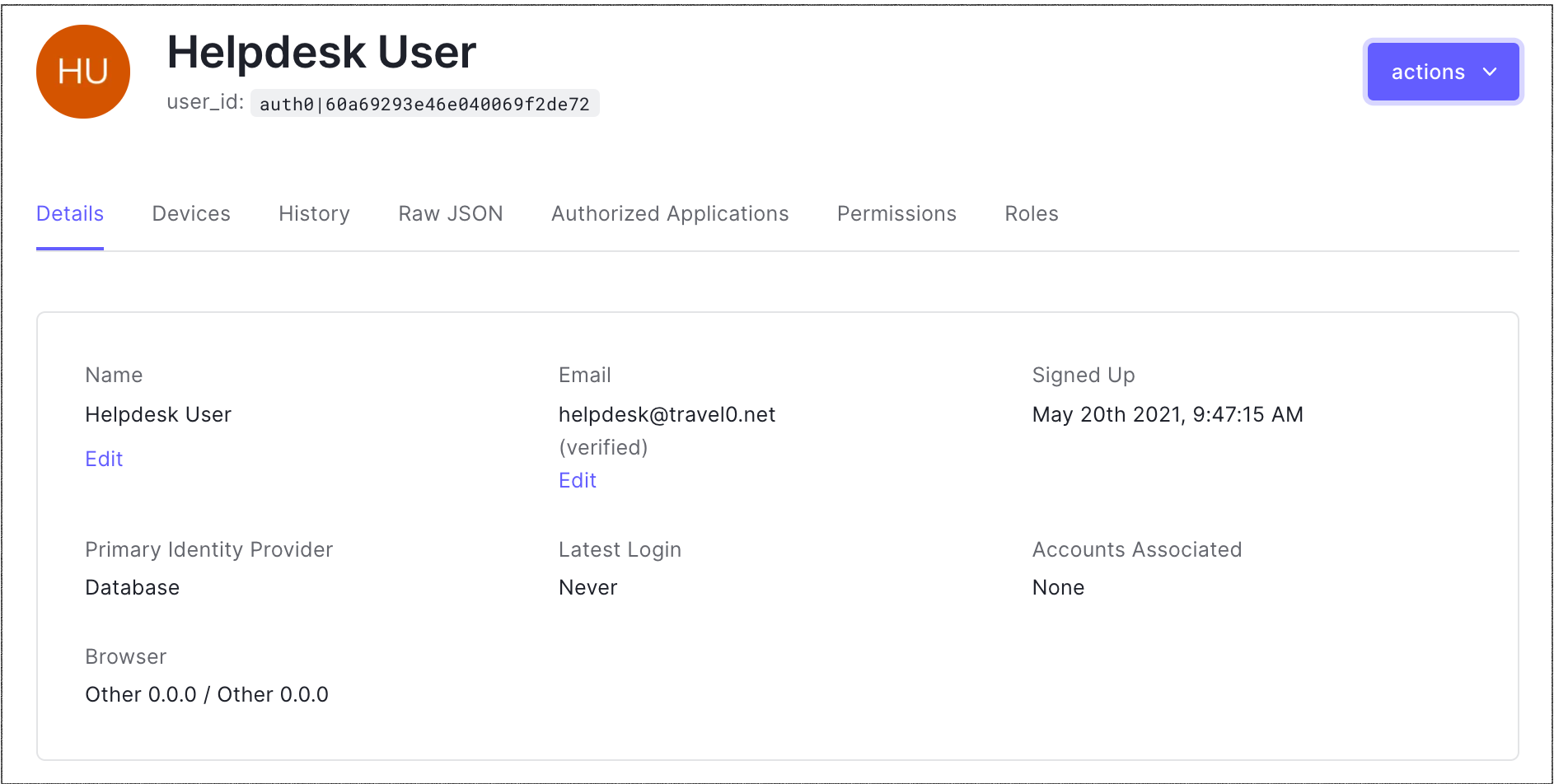Change User Pictures
Auth0 normalizes common profile properties in the User Profile, this includes the name, picture field and more. The picture field is populated by either the social provider profile picture or the Gravatar image associated with the user's email address.
By default, all database users will have a placeholder image with their initials. When you authenticate the user, this picture field is referred to as user.picture.

Use the Management API
The user.picture attribute is not directly editable when provided by identity providers other than Auth0 such as Google, Facebook, Twitter. To edit this attribute, you must configure your connection sync with Auth0 so that user attributes will be updated from the identity provider only on user profile creation. To learn more, read Configure Identity Provider Connection for User Profile Updates. Root attributes will then be available to be edited individually or by bulk import using the Management API. To learn more, read Bulk User Imports.
Alternatively, you can use metadata to store the picture attribute for users. For example, if your app provides a way to upload profile pictures, once the picture is uploaded, you can set the URL to the picture in the user.user_metadata.picture:
curl --request PATCH \
--url 'https://{yourDomain}/api/v2/users/USER_ID' \
--header 'authorization: Bearer ABCD' \
--header 'content-type: application/json' \
--data '{"user_metadata": {"picture": "https://example.com/some-image.png"}}'Was this helpful?
var client = new RestClient("https://{yourDomain}/api/v2/users/USER_ID");
var request = new RestRequest(Method.PATCH);
request.AddHeader("authorization", "Bearer ABCD");
request.AddHeader("content-type", "application/json");
request.AddParameter("application/json", "{\"user_metadata\": {\"picture\": \"https://example.com/some-image.png\"}}", ParameterType.RequestBody);
IRestResponse response = client.Execute(request);Was this helpful?
package main
import (
"fmt"
"strings"
"net/http"
"io/ioutil"
)
func main() {
url := "https://{yourDomain}/api/v2/users/USER_ID"
payload := strings.NewReader("{\"user_metadata\": {\"picture\": \"https://example.com/some-image.png\"}}")
req, _ := http.NewRequest("PATCH", url, payload)
req.Header.Add("authorization", "Bearer ABCD")
req.Header.Add("content-type", "application/json")
res, _ := http.DefaultClient.Do(req)
defer res.Body.Close()
body, _ := ioutil.ReadAll(res.Body)
fmt.Println(res)
fmt.Println(string(body))
}Was this helpful?
HttpResponse<String> response = Unirest.patch("https://{yourDomain}/api/v2/users/USER_ID")
.header("authorization", "Bearer ABCD")
.header("content-type", "application/json")
.body("{\"user_metadata\": {\"picture\": \"https://example.com/some-image.png\"}}")
.asString();Was this helpful?
var axios = require("axios").default;
var options = {
method: 'PATCH',
url: 'https://{yourDomain}/api/v2/users/USER_ID',
headers: {authorization: 'Bearer ABCD', 'content-type': 'application/json'},
data: {user_metadata: {picture: 'https://example.com/some-image.png'}}
};
axios.request(options).then(function (response) {
console.log(response.data);
}).catch(function (error) {
console.error(error);
});Was this helpful?
#import <Foundation/Foundation.h>
NSDictionary *headers = @{ @"authorization": @"Bearer ABCD",
@"content-type": @"application/json" };
NSDictionary *parameters = @{ @"user_metadata": @{ @"picture": @"https://example.com/some-image.png" } };
NSData *postData = [NSJSONSerialization dataWithJSONObject:parameters options:0 error:nil];
NSMutableURLRequest *request = [NSMutableURLRequest requestWithURL:[NSURL URLWithString:@"https://{yourDomain}/api/v2/users/USER_ID"]
cachePolicy:NSURLRequestUseProtocolCachePolicy
timeoutInterval:10.0];
[request setHTTPMethod:@"PATCH"];
[request setAllHTTPHeaderFields:headers];
[request setHTTPBody:postData];
NSURLSession *session = [NSURLSession sharedSession];
NSURLSessionDataTask *dataTask = [session dataTaskWithRequest:request
completionHandler:^(NSData *data, NSURLResponse *response, NSError *error) {
if (error) {
NSLog(@"%@", error);
} else {
NSHTTPURLResponse *httpResponse = (NSHTTPURLResponse *) response;
NSLog(@"%@", httpResponse);
}
}];
[dataTask resume];Was this helpful?
$curl = curl_init();
curl_setopt_array($curl, [
CURLOPT_URL => "https://{yourDomain}/api/v2/users/USER_ID",
CURLOPT_RETURNTRANSFER => true,
CURLOPT_ENCODING => "",
CURLOPT_MAXREDIRS => 10,
CURLOPT_TIMEOUT => 30,
CURLOPT_HTTP_VERSION => CURL_HTTP_VERSION_1_1,
CURLOPT_CUSTOMREQUEST => "PATCH",
CURLOPT_POSTFIELDS => "{\"user_metadata\": {\"picture\": \"https://example.com/some-image.png\"}}",
CURLOPT_HTTPHEADER => [
"authorization: Bearer ABCD",
"content-type: application/json"
],
]);
$response = curl_exec($curl);
$err = curl_error($curl);
curl_close($curl);
if ($err) {
echo "cURL Error #:" . $err;
} else {
echo $response;
}Was this helpful?
import http.client
conn = http.client.HTTPSConnection("")
payload = "{\"user_metadata\": {\"picture\": \"https://example.com/some-image.png\"}}"
headers = {
'authorization': "Bearer ABCD",
'content-type': "application/json"
}
conn.request("PATCH", "/{yourDomain}/api/v2/users/USER_ID", payload, headers)
res = conn.getresponse()
data = res.read()
print(data.decode("utf-8"))Was this helpful?
require 'uri'
require 'net/http'
require 'openssl'
url = URI("https://{yourDomain}/api/v2/users/USER_ID")
http = Net::HTTP.new(url.host, url.port)
http.use_ssl = true
http.verify_mode = OpenSSL::SSL::VERIFY_NONE
request = Net::HTTP::Patch.new(url)
request["authorization"] = 'Bearer ABCD'
request["content-type"] = 'application/json'
request.body = "{\"user_metadata\": {\"picture\": \"https://example.com/some-image.png\"}}"
response = http.request(request)
puts response.read_bodyWas this helpful?
import Foundation
let headers = [
"authorization": "Bearer ABCD",
"content-type": "application/json"
]
let parameters = ["user_metadata": ["picture": "https://example.com/some-image.png"]] as [String : Any]
let postData = JSONSerialization.data(withJSONObject: parameters, options: [])
let request = NSMutableURLRequest(url: NSURL(string: "https://{yourDomain}/api/v2/users/USER_ID")! as URL,
cachePolicy: .useProtocolCachePolicy,
timeoutInterval: 10.0)
request.httpMethod = "PATCH"
request.allHTTPHeaderFields = headers
request.httpBody = postData as Data
let session = URLSession.shared
let dataTask = session.dataTask(with: request as URLRequest, completionHandler: { (data, response, error) -> Void in
if (error != nil) {
print(error)
} else {
let httpResponse = response as? HTTPURLResponse
print(httpResponse)
}
})
dataTask.resume()Was this helpful?
Use Actions
To ensure that the picture from the user_metadata is returned in the ID Token, we'll need to create a new Action to check whether the event.user.user_metadata.picture attribute is present, and if so, replace the user.picture attribute with that value. This ensures that the picture from the user_metadata is returned in the picture claim of the ID Token.
Navigate to Auth0 Dashboard > Actions > Library, and select Build Custom.
Enter a descriptive Name for your Action (for example,
Change user pictures), select theLogin / Post Logintrigger because you’ll be adding the Action to the Login flow, then select Create.Locate the Actions Code Editor, copy the following JavaScript code into it, and select Save Draft to save your changes:
exports.onExecutePostLogin = async (event, api) => { const { picture } = event.user.user_metadata; if (picture) { // Return the persisted user_metadata.picture in the ID token api.idToken.setCustomClaim("picture", picture) } };Was this helpful?
/From the Actions Code Editor sidebar, select Test (play icon), then select Run to test your code.
When you’re ready for the Action to go live, select Deploy.
Finally, add the Action you created to the Login Flow. To learn how to attach Actions to Flows, read the "Attach the Action to a flow" section in Write Your First Action.
Change default picture for all users
To change the default picture for all users who have not set a profile picture, you can use an Action. For example:
exports.onExecutePostLogin = async (event, api) => {
const DEFAULT_PROFILE_IMAGE = '{yourDefaultImageUrl}';
api.idToken.setCustomClaim("picture", {defaultProfileImage});
};Was this helpful?
In this Action, the custom picture is returned in the ID Token and overrides any picture property that may come from an external identity provider login, such as Google.
Limitations
The Auth0 data store is limited and to prevent your application's data from exceeding the limits, we recommend that you use an external database to store user pictures. This allows you to keep your Auth0 data store small and to use a more efficient external database to hold the additional data. To learn more, read User Data Storage.